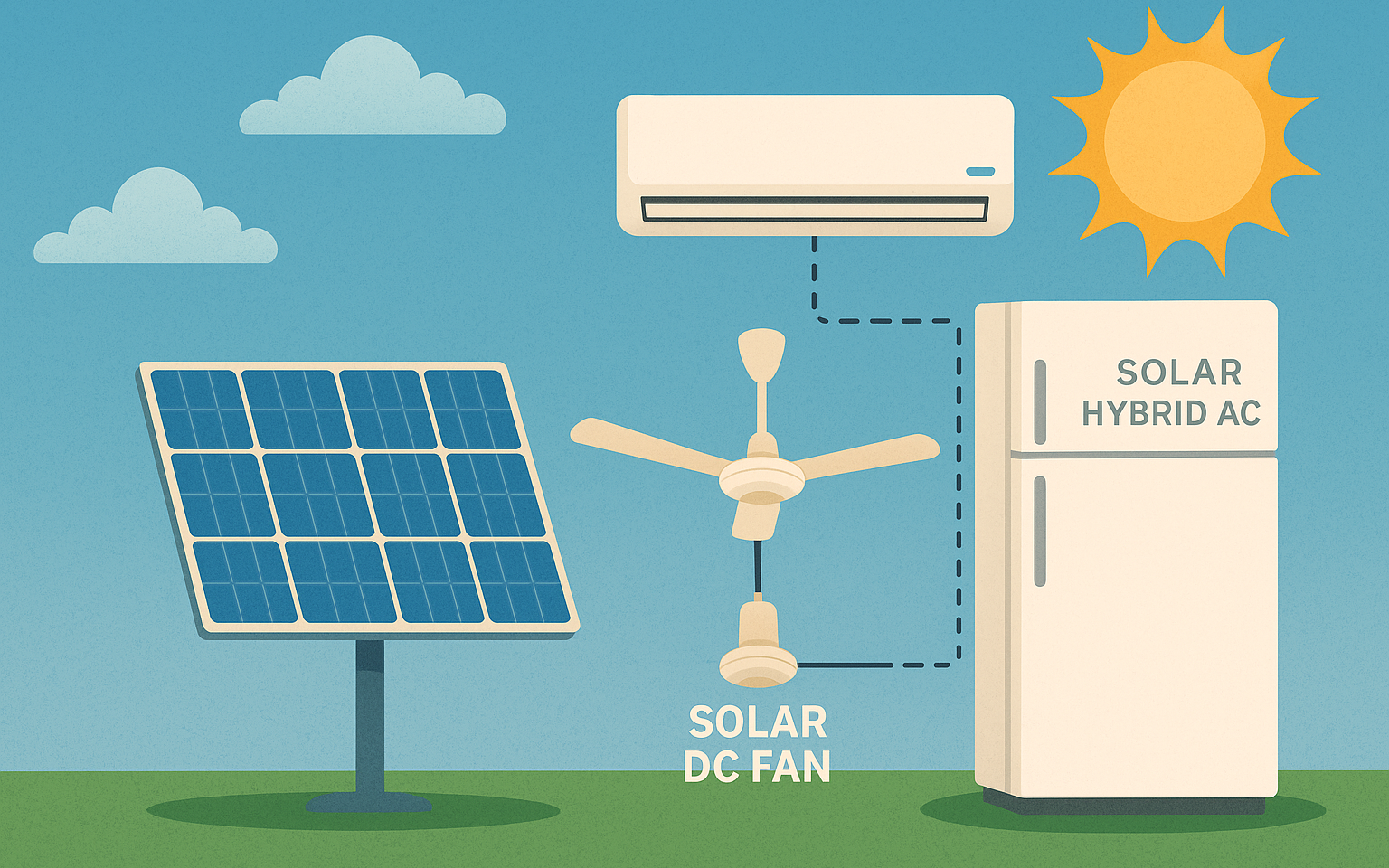Email: info@bastaeco.com
Solar ACs and Fans in Kerala: How Much Money Do You Actually Save?

Solar ACs and Fans in Kerala: How Much Money Do You Actually Save?
We’ve talked about making your home energy-efficient and the magic of BLDC motors. Now, let’s take the ultimate leap: what if you could run your most power-hungry appliances using free, abundant energy from the sun?
The dream of running an air conditioner all afternoon in the sweltering Kerala heat without a single thought for the KSEB meter is incredibly tempting. Companies are now marketing "Solar ACs" and "Solar Fans" that promise to do just that.
But beyond the marketing hype, what are the real, hard numbers? How much can you actually save on your electricity bill by installing these solar-powered wonders? Let's break down the realistic savings, separating the game-changers from the minor wins.
The Easy Win: The Solar-Powered DC Fan
First, let's look at the humble ceiling fan. A "Solar Fan" is typically a hyper-efficient BLDC fan that can run directly on DC power from a dedicated, small solar panel.
The Calculation:
-
Power Consumption: As we learned, a BLDC fan is incredibly efficient. It consumes around 30 watts, compared to an old fan's 75-80 watts.
-
Daily Usage: Let's assume you run this fan for 8 hours during peak sunlight hours (e.g., 9 AM to 5 PM).
-
Energy Saved:
-
Daily Energy: 30 Watts x 8 Hours = 240 Watt-hours, or 0.24 kWh (units of electricity).
-
Monthly Energy: 0.24 kWh x 30 days = 7.2 kWh.
-
-
The Monetary Savings: This is where the KSEB tariff structure matters. The cost per unit in Kerala increases as your total consumption rises (a telescopic tariff). For a household in a middle consumption slab, a unit of electricity might cost around ?7.
-
Monthly Savings Per Fan: 7.2 units x ?7/unit = ?50.40
-
The Verdict on Solar Fans:
A saving of ?50 per month per fan might not sound like a revolution. However, the true value lies elsewhere. If you have a shop, office, or verandah where multiple fans run all day, these savings add up. More importantly, these fans provide relief during daytime power cuts, operating completely off the grid. It's a solid, if modest, win for energy independence.
The Game Changer: The Solar Hybrid AC
This is the big one. A "Solar AC" isn't an AC with a solar panel slapped on top. It’s a sophisticated Solar Hybrid Inverter AC.
Here’s how it works: During the day, the AC intelligently draws power first from the dedicated solar panels. If it's a bright, sunny day, it can run almost entirely on solar power. If it gets cloudy or needs an extra boost, it seamlessly pulls the remaining required power from your KSEB connection. At night, it functions like a normal, high-efficiency inverter AC.
The Calculation:
-
Power Consumption: A modern 1.5 Ton, 5-star inverter AC consumes roughly 1 to 1.5 units (kWh) per hour, depending on the heat load and temperature setting. Let's use a conservative average of 1.2 kWh per hour for our calculation.
-
Daily Usage: Let's say you run the AC for 6 hours during the sunniest part of the day (e.g., 11 AM to 5 PM), a common scenario in many Keralite homes, especially those with children or elderly members.
-
Energy Saved:
-
Daily Energy Saved: 1.2 kWh/hour x 6 hours = 7.2 kWh (units).
-
Monthly Energy Saved: 7.2 kWh x 30 days = 216 kWh.
-
-
The Real Monetary Savings (The KSEB Slab Effect):
This is where the savings become dramatic. An extra 216 units on your bi-monthly bill doesn't just add to the total; it can push your entire consumption into a much higher, more expensive tariff slab. By eliminating these units, you are saving your most expensive electricity.Let's assume your AC usage pushes your bi-monthly bill from a comfortable 400 units to over 600 units. The units above 500 are charged at the highest rate, which can be over ?8 per unit.
-
Monthly Savings: 216 units x ?8/unit = ?1,728
-
The Verdict on Solar ACs:
A potential saving of over ?1,700 per month is transformative. During the 8-9 sunny months in Kerala, this could amount to over ?13,000 in savings per year, from just one appliance.
The Reality Check: Investment vs. Return
Of course, this technology comes at a cost. A solar hybrid AC system (including the unit and the required panels) can cost ?25,000 to ?35,000 more than a standard 5-star inverter AC.
But let's look at the payback period for that additional investment.
-
Additional Cost: Let's take an average of ?30,000.
-
Annual Savings (8 sunny months): ?1,728 x 8 = ?13,824.
-
Payback Period: ?30,000 / ?13,824 per year ≈ 2.17 years.
After just over two years, the extra investment has paid for itself. For the remaining 10+ years of the AC's life, you are pocketing pure savings. This makes the solar hybrid AC one of the best home investments you can make in Kerala today.
Final Thoughts
The answer to "how much can you save?" is clear:
-
Solar Fans offer modest direct savings but provide excellent value during power cuts.
-
Solar Hybrid ACs offer substantial, bill-slashing savings that can fundamentally change your household's energy costs.
The key is to use them when the sun is shining. By aligning your heaviest consumption with the sun's peak hours, you’re not just reducing your bill; you are achieving a new level of energy independence. It’s a smart investment that turns the relentless Kerala sun from a source of heat into a source of incredible savings.







